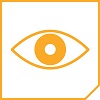Presence detectors
for energy efficient lighting control
With Theben presence sensors, you have all the possibilities for energy-efficient and intelligent lighting control. In addition to the classic use for lighting control in offices, corridors and public buildings, you can also control heating and cooling or even the ventilation system based on presence. This allows you to significantly reduce energy costs and CO2 emissions. Occupancy sensors react to the slightest movement and measure the brightness of the room at the same time. If no further movement is detected or if the lighting is above a certain brightness level, the presence detector automatically switches the light off.

Technology: how the presence sensor works
Presence detectors work on the same principle as motion detectors: they detect thermal radiation in their environment, in the detection area. If thermal radiation is detected in the sensing area, for example a person approaching the presence sensor, the sensor converts the thermal radiation into a measurable electrical signal and the lights switch on.
The difference between motion and presence sensors lies in the sensitivity of the sensors. Presence sensors have much more sensitive sensors than motion sensors and can detect even the smallest movements. Sensitive sensors evenly divide the detection area of a presence sensor into up to 1000 zones. Like a chessboard, the zones are spread over the entire detection area. Even slight changes in the thermal image can be detected, such as typing on a keyboard in an open-plan office. In contrast, a motion sensor only responds to major changes in the thermal image and is therefore primarily used for large movements or outdoor applications.
A further difference between motion and presence sensors is light measurement. A motion sensor measures the luminance once when it detects motion and if there is insufficient natural light, it turns on the lights. If it continuously detects motion without switching off once - for example in a large office or a place where there is constant movement - then even if there is sufficient natural light at any given time, it will not switch off. Motion sensors only measure light intensity when they are switched on. In contrast, presence sensors measure luminance continuously: if the illumination exceeds a certain brightness level, the presence sensor will turn off the light even if it detects motion. This reduces energy costs and significantly reduces CO2 emissions.
 360º square detection range
360º square detection range
Since most rooms are square or rectangular, a square sensing area makes designing very simple. The detection areas of each presence detector can be placed side by side without gaps. In addition to the simplified design, there is another practical advantage: there are no blind spots or overlaps in the room. Movements are guaranteed to be reliably detected everywhere.

Unlike presence detectors with a circular sensing area, square ones ensure optimal coverage of rooms without unnecessary overlaps or gaps.
Light intensity measurement in detail
Lighting control with occupancy sensors is based partly on detected motion and partly on light measurement. Occupancy sensors continuously measure the brightness of the room. Such continuous light measurement enables the presence sensor not only to switch on artificial light when there is not enough natural light, but also to switch off the lighting again when there is enough daylight. It sounds very simple, but in fact the presence detector should be able to estimate whether there will be enough natural light when the artificial light is on and then turn it off.
Switching mode

Constant brightness control

Design and installation
Proper installation of presence sensors
To ensure optimal operation of the presence detector and to avoid sources of interference, a number of factors must be taken into account during installation. For example, suspended lights, partitions, shelving or large plants should not obstruct the field of view of presence detectors. Sudden temperature changes around the presence detector - can cause false detection. Therefore, do not install near heat-generating machinery. Lights that are switched on or off near the detection area (e.g. halogen lights less than 1 m away) simulate movement and may lead to incorrect switching. Moving objects such as machines and robots simulate motion signals or temperature differences. However, slowly warming objects such as radiators (if the distance is greater than 0.5 m), IT equipment (computers, monitors), sunny surfaces or room ventilation systems will not interfere with the presence sensor as long as warm air is not directly directed towards the presence sensor.

Note: Do not install the presence detector near hanging lights, partitions, shelving, indoor plants or appliances with moving parts such as fans or appliances!
Safe design with sensNORM

Free planner for safe sensor positioning
Designers who want to position, use and control their luminaires correctly from the start can benefit from the Relux lighting simulation, which is usually free of charge. Relux offers professional design software for developing and implementing complex lighting control tasks. The software, designed for designers, architects and lighting engineers, is based on lighting solutions from various manufacturers and is preferred by users worldwide. Theben is also a Relux member of the sensors product group.
For more information, www.relux.com

With RED CAD design software, you can design in a professional and efficient way. Thanks to a built-in icon library with proven Theben motion and presence sensors, sensing areas can be quickly and reliably incorporated into designs.
For more information, www.redcad.eu

Simple and effective: the practical benefits of presence detectors
Thanks to their very fine sensor technology, Theben presence detectors can detect even the smallest movements and temperature differences. This allows you to adjust lighting and air conditioning to the exact needs of occupants and users. Depending on the type, the various presence detectors are available in black, white, grey, silver or special colours on request.
 Square detection area
Square detection area
The square detection area is ideal for most rooms where presence detectors are used. This allows individual sensors to be placed in perfect positions without blind spots or unnecessary overlaps. This simplifies design, reduces installation work, saves energy and also reduces investment costs, as the square detection area means that fewer sensors are needed in most cases.
 Self-study delay time
Self-study delay time
The delay time changes automatically depending on people's habits. If the presence detector detects more movement, the delay time is reduced to two minutes. If people move little or rarely, the delay increases to 20 minutes. This saves energy, increases comfort and allows people to work in the way that suits them: active and lively, or calm and focused.
 Sensitive site supervision
Sensitive site supervision
Nothing escapes the presence detector's attention. This is particularly advantageous when the presence detector is integrated into building surveillance systems in large office buildings or other buildings. In this way, the building surveillance always knows which rooms people are still working in.
 Safe staircase lighting function
Safe staircase lighting function
Brilliant sunshine or slight dusk - you can choose between two lighting scenes to suit your mood. Even in conference rooms where the light needs to be dimmed during presentations. For very powerful luminaires in everyday situations. Settings can be saved and changed quickly and easily using the remote control.
 Short-term lighting
Short-term lighting
For short stays, the light only comes on for two minutes. Since the presence sensors detect when someone enters the room and how long they stay, if it is only for a short time, the set delay is not automatically triggered, but they are not left without light.
 Custom lighting images
Custom lighting images
Brilliant sunshine or slight dusk - you can choose between two lighting scenes to suit your mood. Even in conference rooms where the light needs to be dimmed during presentations. For very powerful luminaires in everyday situations. Settings can be saved and changed quickly and easily using the remote control.
 Easy to use remote control
Easy to use remote control
The remote control also makes it easy to manage and change basic settings. It's faster, shortens installation time and reduces costs. What's more, it's safer too.
 Constant brightness control
Constant brightness control
With presence detectors, no one is tripped up - especially on the stairs. The lights can be switched on with a push button, but only switch off when there is no more movement in the stairwell. This means that if someone presses the light switch, it will not turn off as long as someone else is still in the stairwell.
 Practical pulse function
Practical pulse function
The pulse function allows the presence detectors to be integrated into the existing electrical network with staircase lighting light meter switches or KNX binary inputs without the need for expensive modifications.
 Intelligent parallel switching
Intelligent parallel switching
Presence sensors do not only allow you to increase the detection area by master/slave switching operations. The operation of master/master/parallel switching allows the lighting conditions to be set independently and individually in the sensing areas of each device. This is advantageous, for example in open-plan offices, for balancing different lighting conditions between windows and areas in the middle of the room.
 Intelligent teaching function
Intelligent teaching function
Lighting conditions can change quickly, so it's best to simply save them for when they are just right for your needs. The smart teach-in feature even allows end users to save a current LUX value and recall it later
 Adjustable sensitivity
Adjustable sensitivity
How sensitive the presence sensors are to movement in the room is up to you. PIR sensors can be conveniently adjusted by remote control to suit individual user needs.
 Can also be used in wet rooms
Can also be used in wet rooms
The presence and motion detectors with IP 54 protection can also be used in wet rooms such as showers, changing rooms or toilets.
 Intelligent teaching function
Intelligent teaching function
Lighting conditions can change quickly, so it's best to simply save them for when they are just right for your needs. The smart teach-in feature even allows end users to save a current LUX value and recall it later
 High switching power
High switching power
Theben's presence and motion detector relays offer excellent performance with tungsten bias and zero crossing switching, so they can handle switching loads up to 10 amps. This allows multiple lights to be connected simultaneously and illuminate larger areas such as loading ramps or hotel rooms. This can be reassuring when planning, as it reduces costs and shortens installation time.
